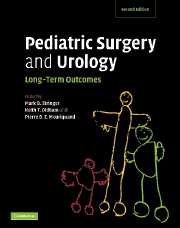Book contents
- Frontmatter
- Contents
- List of contributors
- Acknowledgments
- Preface
- Part I General issues
- Part II Head and neck
- Part III Thorax
- Part IV Abdomen
- Part V Urology
- 41 Introduction
- 42 Upper tract dilation
- 43 Posterior urethral valves
- 44 Vesicoureteric reflux
- 45 Genitoplasty in exstrophy and epispadias
- 46 Feminization (surgical aspects)
- 47 Hypospadias
- 48 Bladder exstrophy
- 49 Surgery for neuropathic bladder and incontinence
- 50 Non-neuropathic bladder–sphincter dysfunction
- 51 Undescended testes
- 52 Circumcision
- 53 The single kidney
- 54 Multicystic kidney
- 55 Urolithiasis
- 56 Gonadal tumors
- Part VI Oncology
- Part VII Transplantation
- Part VIII Trauma
- Part IX Miscellaneous
- Index
- Plate section
- References
41 - Introduction
from Part V - Urology
Published online by Cambridge University Press: 08 January 2010
- Frontmatter
- Contents
- List of contributors
- Acknowledgments
- Preface
- Part I General issues
- Part II Head and neck
- Part III Thorax
- Part IV Abdomen
- Part V Urology
- 41 Introduction
- 42 Upper tract dilation
- 43 Posterior urethral valves
- 44 Vesicoureteric reflux
- 45 Genitoplasty in exstrophy and epispadias
- 46 Feminization (surgical aspects)
- 47 Hypospadias
- 48 Bladder exstrophy
- 49 Surgery for neuropathic bladder and incontinence
- 50 Non-neuropathic bladder–sphincter dysfunction
- 51 Undescended testes
- 52 Circumcision
- 53 The single kidney
- 54 Multicystic kidney
- 55 Urolithiasis
- 56 Gonadal tumors
- Part VI Oncology
- Part VII Transplantation
- Part VIII Trauma
- Part IX Miscellaneous
- Index
- Plate section
- References
Summary
At the dawn of a new millennium, pediatric urology, like adult urology 30 years ago, has become an independent specialty, covering the vast field of congenital and acquired anomalies of the genitourinary (GU) tract in children. This does not mean that it is an insular field. On the contrary, it has very close links with associated pediatric specialties such as pediatric nephrology, pediatric radiology, pediatric endocrinology, and pediatric oncology. The advent and development of antenatal ultrasonography, a better understanding of the pathophysiology of congenital urine flow impairment, the revolution of minimally invasive surgery and robotics, the promising future of tissue engineering, and the improvements in reconstructive surgery of the lower GU tract, have completely changed the management of congenital GU malformations over the last 25 years.
Before getting to the heart of the matter, one should remember that this leap forward in pediatric urology is a result of the hard work and imagination of several memorable surgeons who, well before anyone else, anticipated this evolution and laid the foundation of pediatric urology. It is impossible to list all these pioneering efforts which began in the mid-nineteenth century in the old world, with some daring and precursory ideas in the field of reconstructive surgery and continued in the twentieth century all around the world. However, it would be impossible not to mention here the name of Sir David Innes Williams, who is the genuine father of modern pediatric urology and who had the genius to understand, with a few others, the forthcoming changes in this specialty.
- Type
- Chapter
- Information
- Pediatric Surgery and UrologyLong-Term Outcomes, pp. 531 - 532Publisher: Cambridge University PressPrint publication year: 2006

